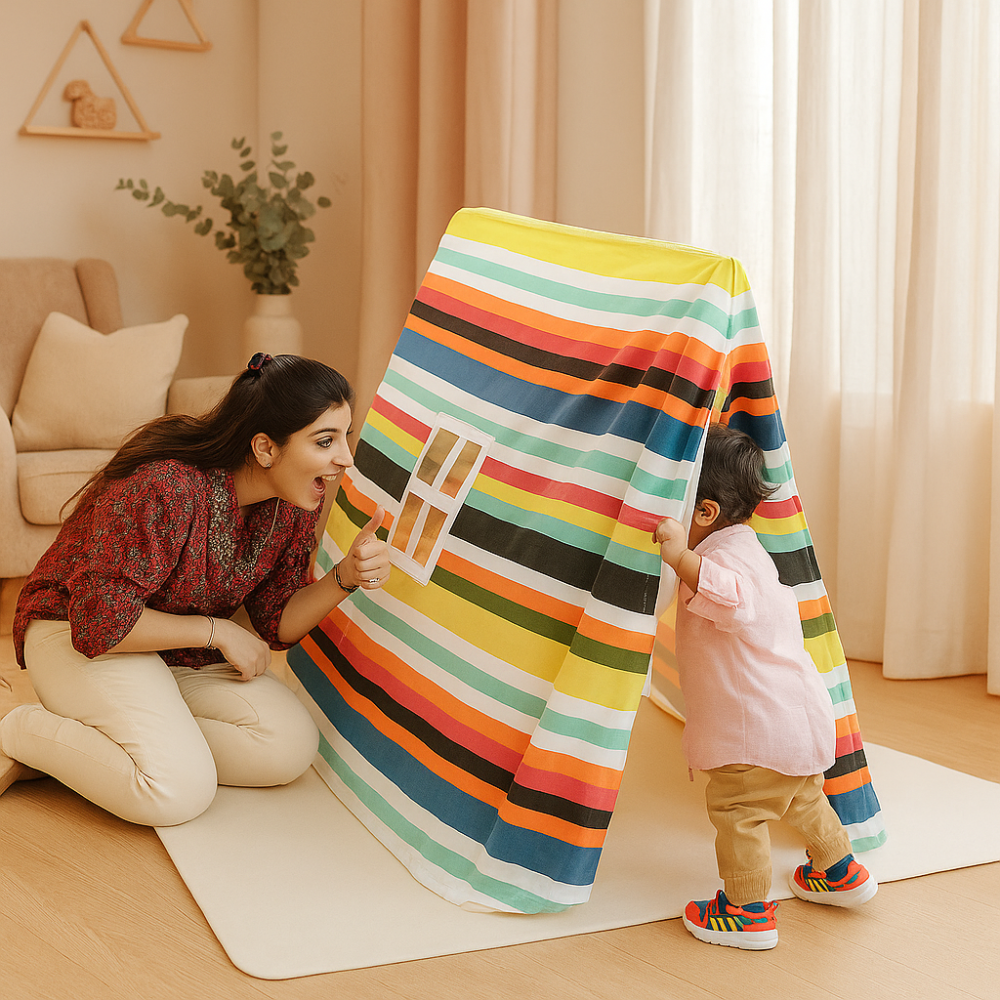There’s something magical about a simple space becoming a child’s kingdom. It could be the blanket draped over two chairs, a cardboard box tipped on its side, or a beautifully designed play tent waiting in the corner of their room. Children don’t see these as mere objects; they see possibility. A play tent isn’t just a piece of fabric and poles—it’s a castle, a spaceship, a bakery, or the quiet corner of a secret library. For parents, it’s more than a toy; it’s a doorway to a world of creativity and independent play that nurtures skills they’ll carry for a lifetime.
The Allure of a World Within Four Fabric Walls
Watch a child the first time they crawl into a play tent, and you’ll see it happen—the shift. Their movements slow, their eyes widen, and suddenly, they’ve stepped out of the living room and into a universe of their own making. That’s the beauty of a play tent: it creates a boundary without feeling restrictive. Inside those walls, kids feel like they own the space. It’s theirs to decorate, theirs to imagine, theirs to rule.
For many children, that sense of ownership is powerful. It’s the first time they have a little world where they set the rules. Today it’s a doctor’s clinic; tomorrow, it’s a pirate ship. That freedom to transform their surroundings fuels creativity in ways no flashing, battery-powered toy ever could.
Building Stories from Scratch
Kids are natural storytellers. Give them a stick, and suddenly it’s a sword. Hand them a cardboard box, and you’ll hear about their submarine adventure by dinnertime. Play tents give those stories a stage.
Inside a tent, the ordinary rules of the house don’t apply. The coffee table isn’t a coffee table—it’s now part of the dragon’s lair outside their castle walls. The couch isn’t furniture; it’s a mountain they must climb to retrieve the magic jewel. The tent becomes the constant, the anchor for their tales, while everything around it changes in their imaginations.
When children play this way, they aren’t just having fun—they’re practicing critical skills. They learn how to structure stories, create characters, and solve problems when their characters get stuck. They’re stretching their imagination muscles, laying the groundwork for creative thinking that will help them in school, friendships, and even future careers.
A Gentle Nudge Toward Independence
If you’ve ever seen your child glued to your side all day, you know the tug between wanting to be their safe space and needing them to feel comfortable exploring on their own. That’s where play tents step in beautifully.
A play tent is a soft invitation toward independence. It’s not sending them outside into the big, wide world; it’s giving them a corner of the living room, a patch of the bedroom, that’s all theirs. It’s a safe middle ground—close enough to hear you in the kitchen, but far enough that they get to try things on their own.
You’ll see it when they sit inside and start talking to their stuffed animals like old friends, or when they line up their books and pretend they’re the librarian. It’s those moments of quiet play, unprompted and unsupervised, that help kids build confidence. They realize they can entertain themselves, create their own fun, and rely on their imagination, not just on someone else’s direction.
The Comfort of a Safe Haven
For some children, the world can feel overwhelming. The noise, the movement, the constant hum of activity—it’s a lot to take in. A play tent provides more than fun; it provides refuge.
There’s something calming about having a little space that feels cozy and contained. Inside, kids can shut out the overstimulation and retreat into quiet comfort. Some use it to read, others to daydream, and some just sit with their favorite blanket and watch the light filter through the fabric.
This sense of security is vital for emotional well-being. Children learn that it’s okay to take a break, to recharge, to have a corner where they can breathe. For sensitive or shy kids, especially, this little oasis can make the difference between feeling safe in their home environment and feeling constantly on edge.
Play Tents and the Art of Sharing
At first glance, a play tent might look like a solo activity. But give it time, and you’ll see how easily it becomes a hub for connection.
Siblings turn the tent into a secret clubhouse with its own rules and handshake. Friends gather inside during playdates, huddling together to hatch plans for their next “mission.” Even parents are often invited in for “tea” or to listen to an impromptu puppet show.
Through this shared play, kids practice negotiation and teamwork. Whose turn is it to be the shopkeeper? What happens if someone wants to be a dragon and someone else wants to be a knight? These are the tiny, important moments where they learn to compromise, to communicate, and to collaborate.
A Place Where Screens Don’t Matter
We live in a world where screens are everywhere—sometimes even in the smallest hands. While tablets and TV have their place, it’s refreshing to see the way a simple play tent can lure a child away from them.
Inside the tent, the games are made up, the props are imaginary, and the storylines shift by the second. There’s no preset script or preloaded game level—they have to invent it all. That unplugged play is invaluable. It forces their brain to do the heavy lifting, encourages physical movement, and reminds them that some of the best adventures don’t need Wi-Fi.
Designing the Space for Imagination
What makes a play tent even more special is how kids personalize it. Parents often notice that as soon as the tent is up, their child starts “decorating.” A pillow here, a blanket draped just so, maybe a sign that says “No Grown-Ups Allowed.”
This instinct to design their own space is a huge part of the experience. It teaches them about making choices—what feels cozy, what feels fun, what feels them. They’re learning about style, organization, and even boundaries as they tell you that the purple unicorn plushie is allowed in the tent, but the blue one “doesn’t match.”
For parents, this is an opportunity, too. You can help by providing little touches—fairy lights, soft rugs, or baskets for their treasures—that make the tent even more inviting. But ultimately, letting your child take the lead is what makes the tent truly theirs.
The Role of Play Tents in Childhood Memories
Think back to your own childhood. Chances are, you have a memory of building forts from couch cushions or hiding under the dining table with a blanket draped over the chairs. Those weren’t just moments of play—they were moments of magic.
Play tents create that same kind of memory for your kids. One day, they’ll be grown, and they won’t remember every toy they owned. But they’ll remember the afternoons spent giggling under the soft glow of their tent’s fabric, the whispered secrets with a sibling, the rainy day that turned into an indoor camping trip.
That’s the beauty of giving them this simple space—it’s not just entertainment for now, it’s a gift for the future.
Choosing the Right Play Tent
Not all play tents are created equal, and parents know this instinctively. A flimsy tent that tips over with the slightest bump won’t inspire much magic—it’ll just lead to frustration. Choosing the right play tent means finding one that balances durability with comfort, and practicality with charm.
The material should feel soft and safe against their skin but sturdy enough to withstand enthusiastic play. The structure should be stable yet easy to move around, because let’s face it, today’s castle might need to become tomorrow’s pirate cove in another room. And of course, it should feel inviting—something your child looks at and can’t wait to step inside.
Investing in a well-made play tent means investing in years of imagination. The right one becomes a fixture in their childhood, not a forgotten toy stuffed in the closet.
Why Play Tents Are More Than “Just a Toy”
It’s easy to see a play tent as just another thing in the room—a place for kids to play and then move on from. But spend time watching how they use it, and you’ll see it’s so much more.
It’s a creativity lab, where stories are born.
It’s a sanctuary, where they learn to calm themselves.
It’s a training ground for independence, teamwork, and self-expression.
Play tents take the simplest of materials and turn them into something priceless: a space where your child’s imagination can run wild, unrestricted and unjudged.
Suggested Reading: Burp Sheets That Do More: From Spit-Ups to Style Statements
Conclusion
There’s a reason play tents have become such a beloved addition to so many homes—they’re not just playthings, they’re tools for growth, joy, and connection. They spark creativity, encourage independent play, and provide a safe, magical corner of the world for little minds to explore. In that small space, kids build worlds, solve problems, and learn lessons they’ll carry far beyond the fabric walls.
If you’re thinking about giving your child the gift of imagination wrapped in a simple, beautiful tent, Happy Matty is a wonderful place to start. Their thoughtfully crafted play tents aren’t just made for fun—they’re designed to become part of your child’s happiest memories, inspiring countless stories, adventures, and moments of joy.



